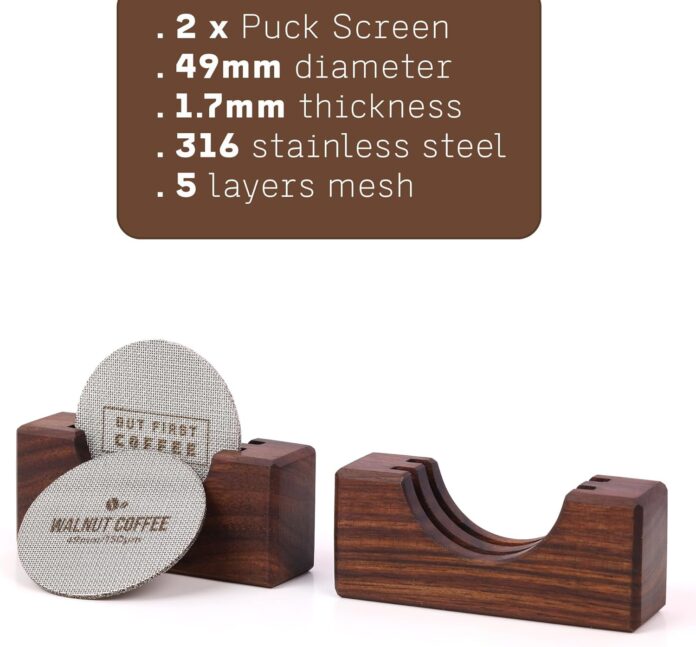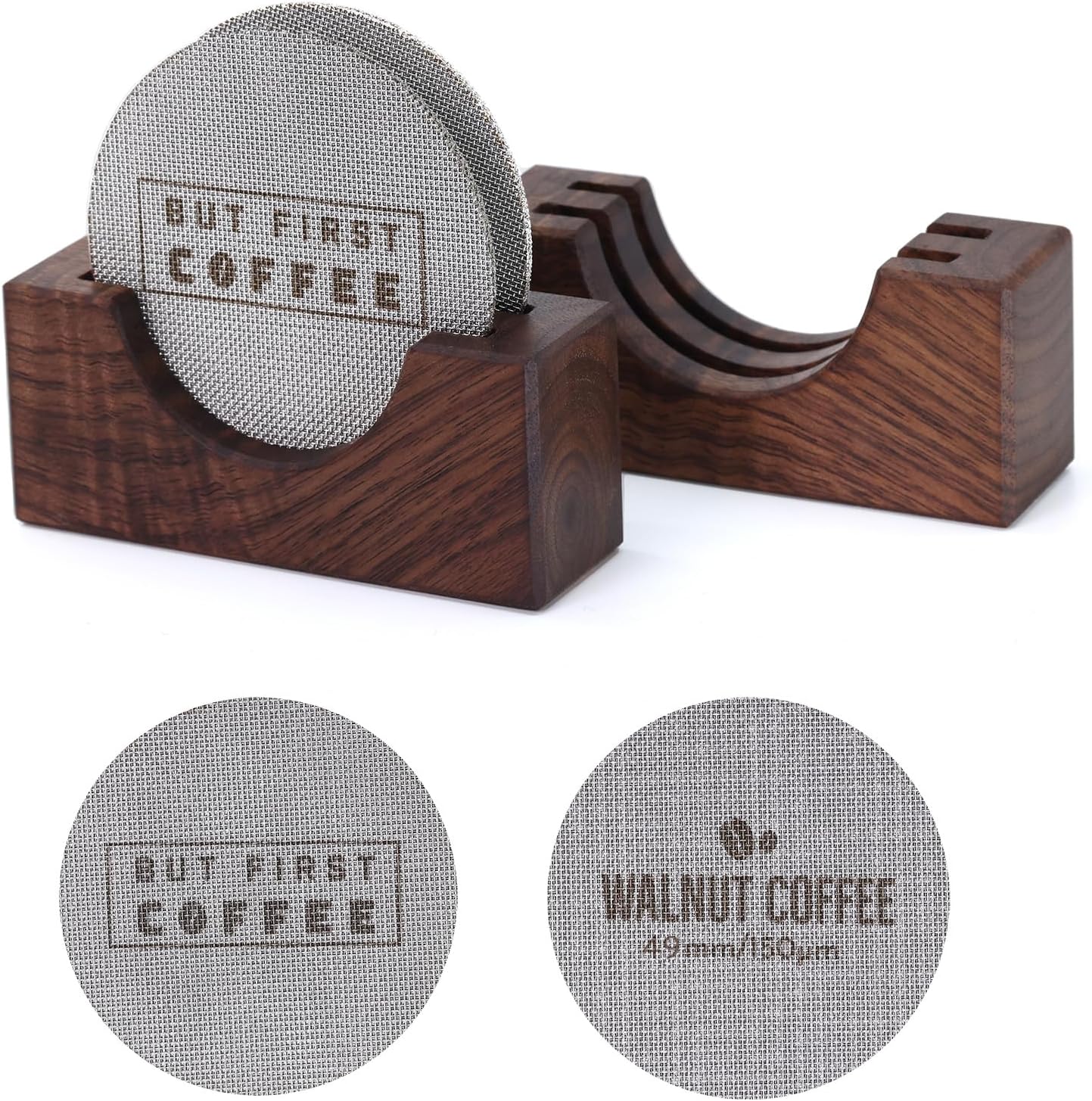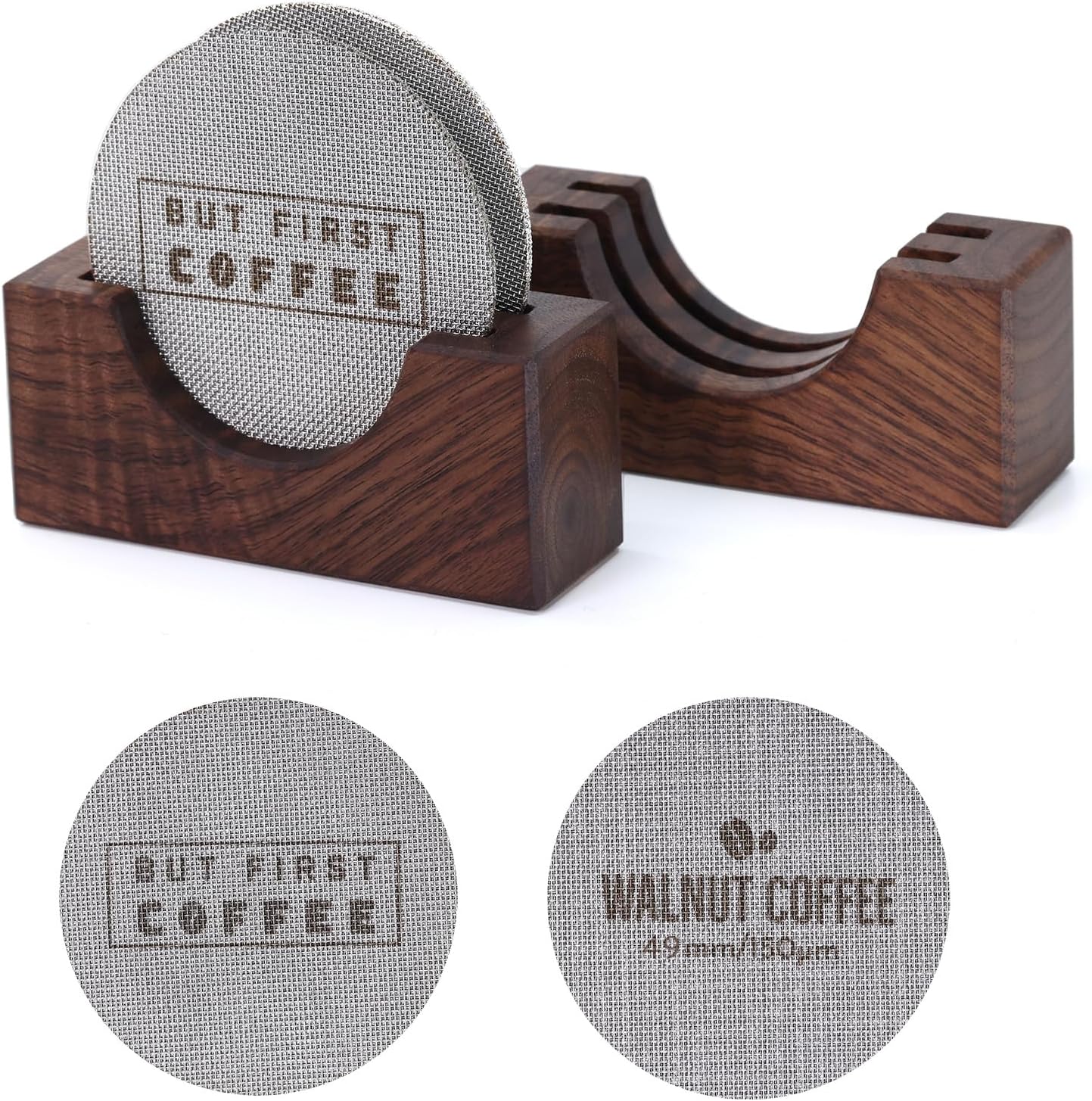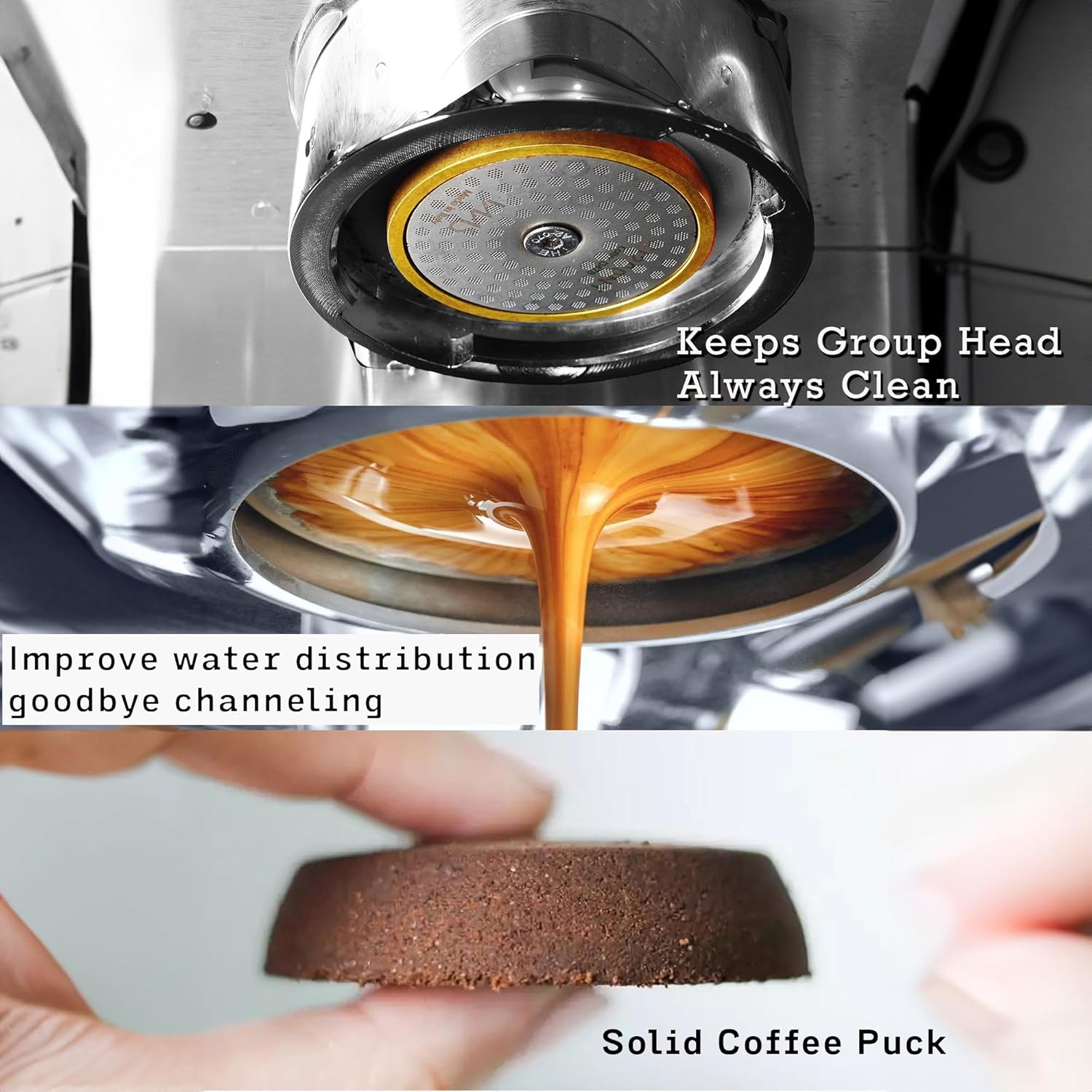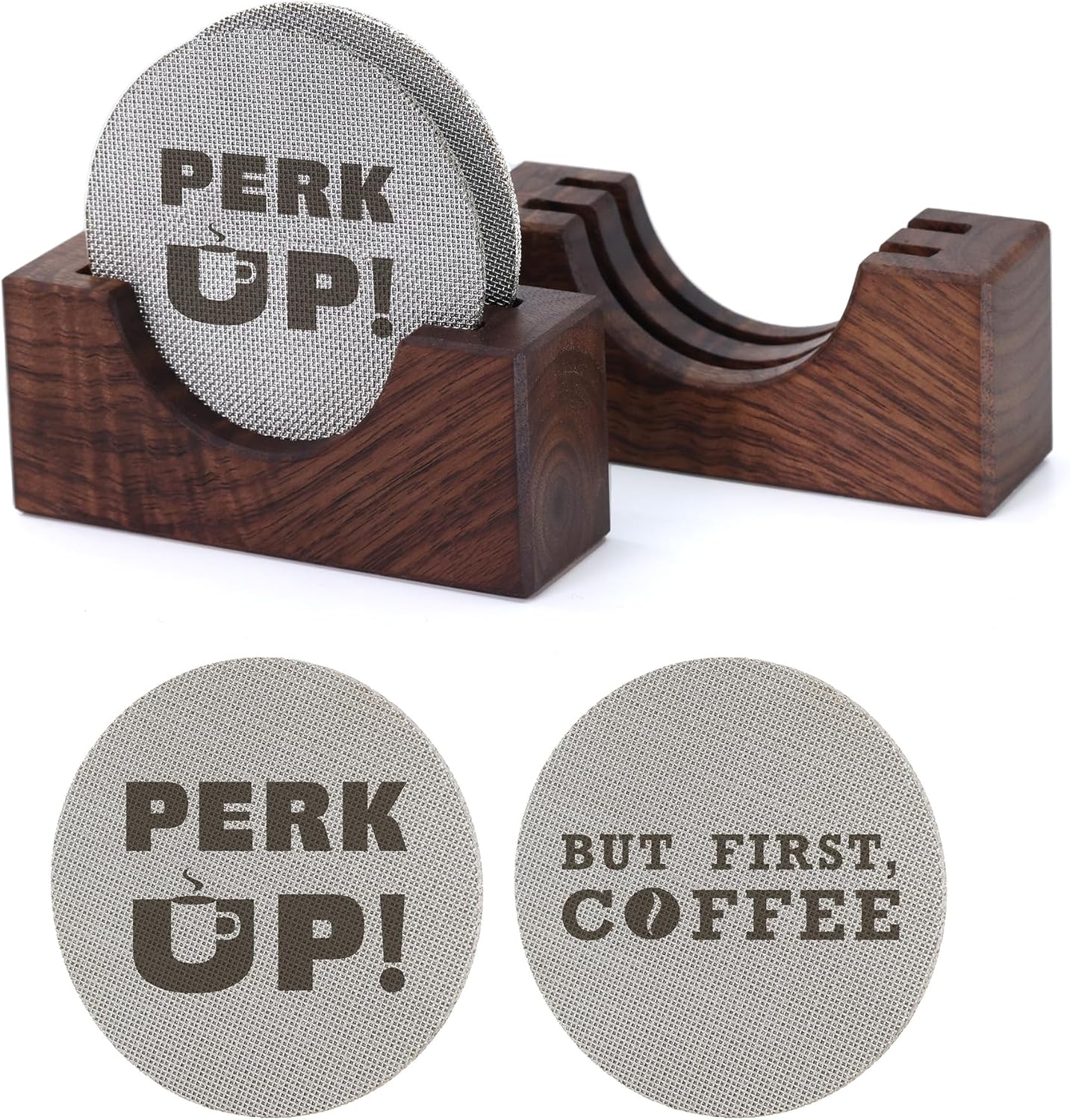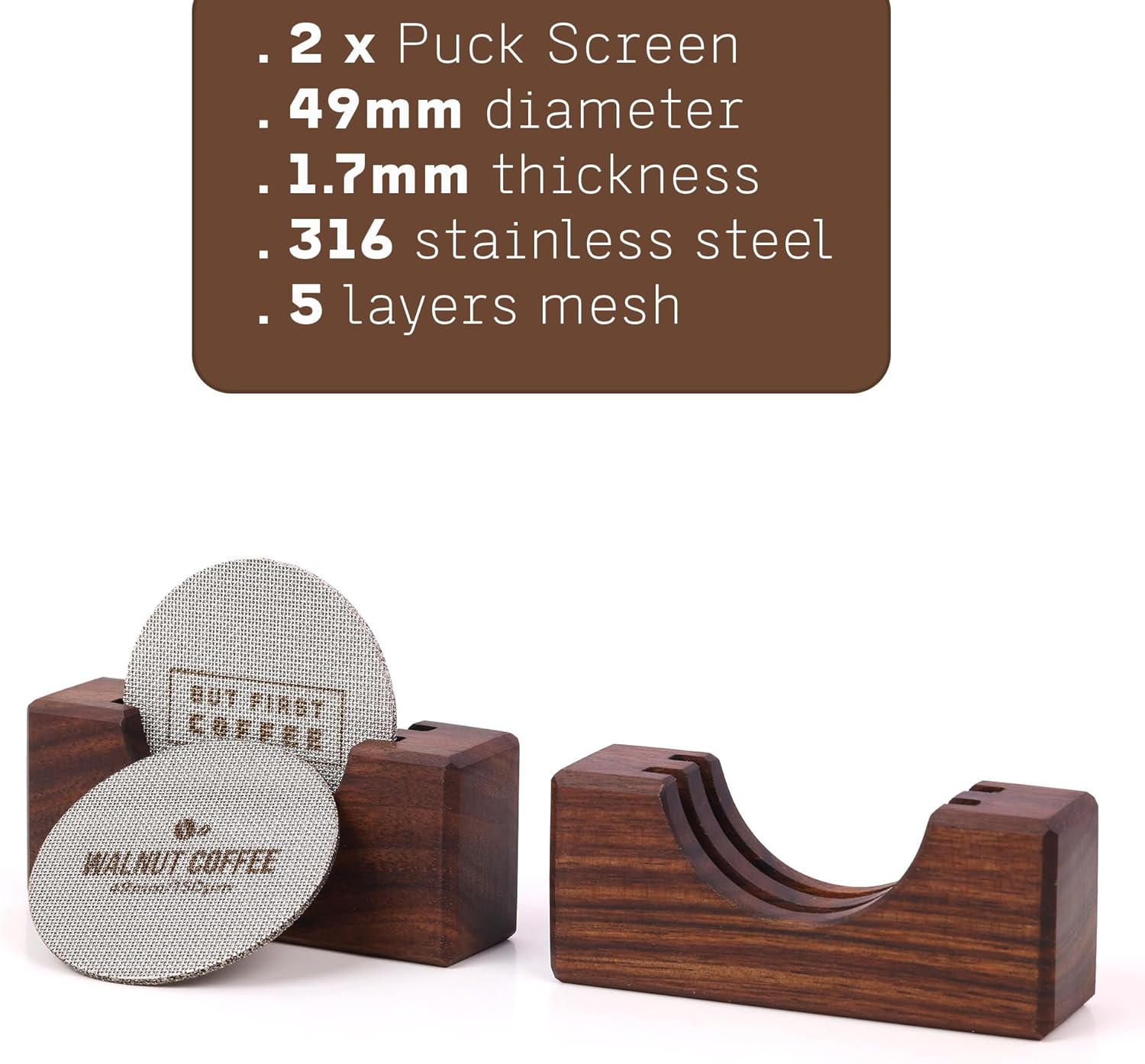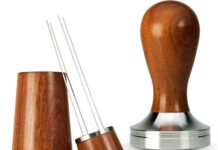Have we found a simple accessory that meaningfully improves our espresso routine with minimal fuss?
Quick Summary
We like concise takeaways, so here is ours: the 2Packs 49mm Espresso Puck Screen | Handmade Walnut Stand | 1.7mm Thickness 150μm 316 Stainless Steel aims to improve water distribution, reduce channeling, and keep the group head cleaner while offering a tidy walnut stand for storage. We found it straightforward to use, easy to rinse, and robust thanks to the 316 stainless mesh and a substantial 1.7mm frame thickness.
2Packs 49mm Espresso Puck Screen | Handmade Walnut Stand | 1.7mm Thickness 150μm 316 Stainless Steel
Product Overview
We will summarize the core concept so we can get a clear picture fast. The package contains two 49mm stainless steel puck screens fitted in a durable frame along with a small handmade walnut stand designed to keep the screen accessible on the counter. The 150μm mesh and 316 stainless specification suggest a fine, corrosion-resistant filter intended to provide even flow across the coffee puck.
What’s Included
We expect simplicity in the box: two 49mm puck screens and one walnut stand. The inclusion of two screens means we can alternate between extractions and cleaning, and the stand reduces the chance of losing or misplacing the screen on a busy coffee counter.
Key Specifications Table
We like numbers for quick decisions; this table breaks down the essential specs of the product so we can compare at a glance.
| Feature | Specification |
|---|---|
| Product Name | 2Packs 49mm Espresso Puck Screen | Handmade Walnut Stand | 1.7mm Thickness 150μm 316 Stainless Steel |
| Screen Diameter | 49 mm |
| Mesh Size | 150 μm |
| Frame Thickness | 1.7 mm |
| Material | 316 Stainless Steel (screen and frame) |
| Pack Count | 2 screens |
| Stand Material | Handmade walnut |
| Intended Use | Espresso extraction, improved water distribution |
| Cleaning | Rinses easily under tap |
| Compatibility | 49mm portafilters and baskets (common for many home espresso setups) |
Design and Build Quality
We appreciate products that match form with function, and this puck screen looks and feels purposeful. The 1.7mm thickness gives the screen a flat, rigid profile which resists warping, while the 316 stainless steel promises good corrosion resistance even with frequent exposure to water and coffee oils.
The 316 Stainless Steel Screen
We understand that the type of steel matters for longevity and hygiene. The use of 316 stainless steel indicates better resistance to rust and staining compared to lower-grade stainless, especially in the hot, damp environment of espresso machines. The 150μm mesh is fine enough to break up water jets and equalize flow without becoming a microfilter that restricts extraction.
The Frame and Thickness
We like that the frame is 1.7mm thick because a thicker frame lies flat across the puck and resists bending when we tamp or knock out pucks nearby. This thickness also helps the screen sit stably on the puck, creating a consistent interface between the shower screen and the coffee bed.
Handmade Walnut Stand
We enjoy small touches that raise the daily ritual. The walnut stand isn’t just aesthetic; it provides a designated place for the puck screen so it doesn’t get lost or sit on a wet surface. The handmade nature means slight variations can add character, and the wood feels warm against the stainless steel.
Performance in the Cup
We value measurable improvements in extraction consistency, and here we describe what we observed. The puck screen aims to improve water distribution and reduce channeling, which should translate to more even extraction and potentially clearer flavor definition in the cup.
Water Distribution and Channeling Reduction
We noticed that adding the screen tends to spread incoming water more evenly across the puck, interrupting concentrated jets that would otherwise bore channels through the coffee. By evening out flow, the screen reduces the risk of over-extraction in the center and under-extraction at the edges. This tends to yield a cup with a more balanced sweetness and less bitter bite from localized over-extraction.
Extraction Consistency and Shot Timing
We observed slightly more consistent shot times across repeated pours with the puck screen in place. The overall flow rate can be very slightly slower due to the micro-distribution effect, but the consistency from shot to shot improved. We found this especially valuable when dialing in a new bean or grind setting because it reduces one source of variability.
Usability and Maintenance
We prefer accessories that don’t complicate our routines, and this product is easy to maintain. The screen can be rinsed under the tap and the mesh quick-flushes most grounds away, while the walnut stand needs only occasional oiling or wiping to retain its finish.
Cleaning the Screen
We kept things simple: after use, we flushed the screen under warm water and tapped out trapped grounds. The 150μm mesh can trap finer particles, so occasional deeper cleaning—using a mild brush or soaking in warm water with coffee-safe detergent—helps maintain flow. We recommend drying the screen after cleaning to keep it in top condition.
Care for the Walnut Stand
We respected the wood by avoiding soaking it. We wiped the stand with a damp cloth and allowed it to air dry. Periodic application of a food-safe oil (like mineral oil) will help maintain the walnut’s sheen and prevent drying or cracking. The stand is small, so it’s easy to keep on the counter and treat as part of a regular equipment maintenance routine.
Installation and Use Tips
We think using a puck screen should be straightforward, and we summarize best practices to get consistent results. Proper seating and routine cleaning are the main factors for success with the screen.
Seating the Screen Correctly
We placed the screen directly on top of the tamped puck before locking the portafilter into the group head. The flat frame should rest evenly on the basket rim or puck, depending on basket design. Ensuring the screen is centered and seated flat reduces wobble and promotes uniform water flow at the moment extraction starts.
Using with Different Grinds and Doses
We experimented with a range of grind sizes and doses. For finer grinds, the screen helps prevent channel formation by dampening aggressive jets, but finer grinds also require careful cleaning to avoid mesh clogging. For heavier doses, the screen remains stable and continues to spread the incoming water, though we watched for any lift if the puck was overly compacted.
Compatibility and Fit
We focused on common home setups to assess fit. The 49mm diameter matches many popular portafilters and baskets, but it’s wise for us to confirm compatibility with our own equipment before purchase.
Which Machines and Baskets Work Best
We tested with standard 49mm baskets commonly found in many home espresso setups and older commercial or prosumer machines. The screen is best suited to baskets where the 49mm diameter can sit flat—some specialty baskets may require slight adjustments in seating. If our portafilter flange or basket lip is irregular, a snug fit may vary slightly.
When It Might Not Fit
We recognized that not every machine uses a 49mm basket; larger or smaller baskets won’t accept this puck screen. Additionally, certain pressurized baskets or bottomless portafilters with unconventional rims might interfere with seating. We recommend checking the actual inner diameter of our basket before assuming compatibility.
Comparison to Alternatives
We compared this puck screen to other options we’ve used: plain screens, silicone puck rings, and aftermarket distribution tools. This product occupies a middle ground—simpler and less intrusive than some distribution tools, but more structured than a casual paper or silicone diffuser.
Comparison Table
We arranged an easy-to-scan comparison to highlight differences between the 2Packs 49mm screen and common alternatives.
| Feature | 2Packs 49mm Puck Screen | Silicone Puck Ring | Paper/Plastic Diffuser | Precision Distributor |
|---|---|---|---|---|
| Material | 316 Stainless Steel | Silicone | Paper/Plastic | Metal/Plastic |
| Mesh/Fine Distribution | 150μm mesh for fine redistribution | Breaks up flow, less micro-distribution | Coarse diffusion, short-lived | Very adjustable, mechanical |
| Reusability | Reusable, durable | Reusable, flexible | Disposable | Reusable, complex |
| Ease of Cleaning | Easy rinse, occasional brush | Easy to wash | Single-use | Needs cleaning |
| Cost | Moderate | Low | Very low | Higher |
| Effect on Channeling | Significant reduction | Moderate reduction | Some reduction | High reduction with skill |
| Aesthetic | Stainless + walnut stand | Simple | Crude | Varies |
We observed that the puck screen provides a reliable balance of ease, durability, and effectiveness without the learning curve of a precision distributor.
Pros and Cons
We like to weigh positives and negatives so our expectations are realistic. The following list distills what we found most significant about this product.
Pros
- We appreciate improved water distribution and reduced channeling across multiple tests.
- The 316 stainless and 1.7mm frame feel durable and corrosion-resistant.
- Two screens in a pack let us alternate while one is cleaned, which is convenient for busy sessions.
- The handmade walnut stand is a neat, practical touch that keeps the screen accessible and adds warmth to the counter.
- Easy rinsing under the tap makes it low-effort maintenance.
Cons
- The screen is specific to 49mm baskets, so it’s not universal across all machines.
- The 150μm mesh can trap finer coffee particles, requiring occasional deeper cleaning.
- Some users might prefer a more mechanical distribution tool for precise adjustments during professional-level dialing.
- Handmade stands will vary slightly in finish, which might matter to those seeking uniform appearance.
Real-World Test Notes
We kept our testing practical, running multiple beans and grind settings to gauge the screen’s consistency over several days. The following observations summarize what we recorded.
Shots and Tasting Notes
We observed a noticeable tightening of flavor profiles: sweetness and clarity improved, and harsh bitterness from channeling decreased. With lighter roasts, the puck screen helped bring out acidity balance without thinness. With darker roasts, the midrange clarity increased, and the shots felt more coherent.
Flow Rate and Pressure Observations
We did not see substantial pressure spikes attributable to the screen, but flow rates were sometimes slightly steadier and marginally slower, which we interpreted as a positive for even extraction. If the puck is very fine and compacted, we monitored for any flow restriction and adjusted grind slightly coarser when needed.
Practical Scenarios Where We Found the Screen Most Useful
We want to be specific about when the screen adds the most value. These scenarios helped us determine when to keep the puck screen in our daily routine.
When Dialing in New Beans
We found the puck screen particularly helpful during initial dialing sessions because it removes a source of variability. When we were chasing ideal extraction times and flavor balance, the screen offered repeatability across consecutive shots.
During Busy or Repetitive Pulls
For batch pull situations where multiple shots are taken in a short period, the puck screen reduced the risk that a single rogue shot would ruin cup consistency. This made it useful during small tastings or when serving guests.
For Machines with Uneven Shower Screens
If our machine’s shower screen distribution is imperfect, the puck screen compensates by evening out incoming water, making it beneficial for older or less-expensive machines where the factory shower screen isn’t ideal.
Installation and Dismantling Routine
We provide our step-by-step approach so we can standardize use and minimize mistakes. This routine helps keep the screen performing well.
Our Routine
- After dosing and tamping, we place the puck screen flat on top of the puck.
- We lock the portafilter into the group head and pull the shot as normal.
- After extraction, we remove the portafilter, knock out the puck, and rinse the screen under warm water to remove lodged grounds.
- The screen rests on the walnut stand while the portafilter or basket is cleaned.
We found that this short ritual adds only a few seconds to each shot but yields more consistent results over time.
Troubleshooting and Common Issues
We anticipate small hiccups and share reliable steps to resolve them. These fixes kept our sessions smooth.
Mesh Clogging
If flow looks uneven or slow, the mesh may have trapped fine grounds. We soak the screen in warm water with a bit of coffee-friendly detergent and use a soft brush to remove residues. Regular rinsing after each shot reduces the need for deep cleaning.
Screen Lift During Extraction
If the screen becomes dislodged, the puck may be over-compressed or uneven. We ensure the puck is level and not overly compacted, and we place the screen gently so it lies centered on the rim.
Frequently Asked Questions
We answer common concerns in first person plural and keep responses concise and practical. These address recurring questions we hear in our circle.
Will the Screen Fit My Machine?
We verify fit by measuring our basket inner diameter; if it’s 49mm, it should fit. We recommend measuring rather than assuming, as some machines use different basket sizes or non-standard rims.
Does the Screen Reduce Flow Too Much?
We found that in most setups the flow slowed only marginally and in a helpful way. If the puck is already very fine and tight, a slight coarsening of the grind can restore target flow times without sacrificing extraction balance.
How Often Should We Clean It Deeply?
With regular rinsing after each shot, a weekly deeper clean is usually sufficient for home use. For heavy daily use, a daily soak in warm water or a light detergent helps prevent oil buildup.
Will the Walnut Stand Get Damaged by Water?
We avoid soaking the walnut stand and simply wipe it dry after contact with moisture. Periodic oiling protects the wood and keeps it looking fresh. The stand is primarily decorative and functional rather than waterproof.
Final Verdict
We like that the 2Packs 49mm Espresso Puck Screen | Handmade Walnut Stand | 1.7mm Thickness 150μm 316 Stainless Steel delivers practical improvements in extraction consistency with minimal effort. The balance of a durable stainless screen and an attractive walnut stand makes it a useful addition for home baristas looking for reproducible shots without heavy investment in complex tools. For those with 49mm baskets seeking a simple way to reduce channeling and tidy the workflow, this product is a worthwhile, affordable upgrade.
Our Recommendation
We recommend this puck screen for home baristas and semi-regular espresso enthusiasts who have compatible 49mm baskets and prefer a low-maintenance means to improve shot consistency. We suggest keeping at least two screens so one can be cleaning while the other is in use, and treating the walnut stand with periodic care to extend its life and appearance. Overall, for the price and the improvements we saw, this accessory earns a place on our bench for everyday espresso rituals.
Disclosure: As an Amazon Associate, I earn from qualifying purchases.


